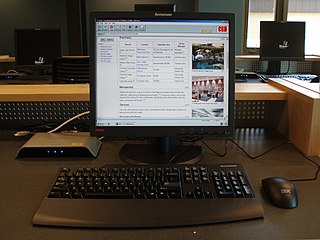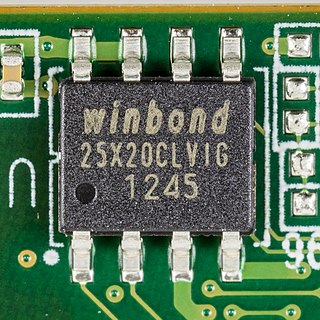Malware is any software intentionally designed to cause disruption to a computer, server, client, or computer network, leak private information, gain unauthorized access to information or systems, deprive access to information, or which unknowingly interferes with the user's computer security and privacy. Researchers tend to classify malware into one or more sub-types.
In computing terminology, a macro virus is a virus that is written in a macro language: a programming language which is embedded inside a software application. Some applications, such as Microsoft Office, Excel, PowerPoint allow macro programs to be embedded in documents such that the macros are run automatically when the document is opened, and this provides a distinct mechanism by which malicious computer instructions can spread. This is one reason it can be dangerous to open unexpected attachments in e-mails. Many antivirus programs can detect macro viruses; however, the macro virus' behavior can still be difficult to detect.
Spyware is any software with malicious behavior that aims to gather information about a person or organization and send it to another entity in a way that harms the user by violating their privacy, endangering their device's security, or other means. This behavior may be present in malware and in legitimate software. Websites may engage in spyware behaviors like web tracking. Hardware devices may also be affected.

In computer networking, a thin client, sometimes called slim client or lean client, is a simple (low-performance) computer that has been optimized for establishing a remote connection with a server-based computing environment. They are sometimes known as network computers, or in their simplest form as zero clients. The server does most of the work, which can include launching software programs, performing calculations, and storing data. This contrasts with a rich client or a conventional personal computer; the former is also intended for working in a client–server model but has significant local processing power, while the latter aims to perform its function mostly locally.

In computing, firmware is software that provides low-level control of computing device hardware. For a relatively simple device, firmware may perform all control, monitoring and data manipulation functionality. For a more complex device, firmware may provide relatively low-level control as well as hardware abstraction services to higher-level software such as an operating system.

A webcam is a video camera which is designed to record or stream to a computer or computer network. They are primarily used in video telephony, live streaming and social media, and security. Webcams can be built-in computer hardware or peripheral devices, and are commonly connected to a device using USB or wireless protocols.

A software protection dongle is an electronic copy protection and content protection device. When connected to a computer or other electronics, they unlock software functionality or decode content. The hardware key is programmed with a product key or other cryptographic protection mechanism and functions via an electrical connector to an external bus of the computer or appliance.
Installation of a computer program, is the act of making the program ready for execution. Installation refers to the particular configuration of software or hardware with a view to making it usable with the computer. A soft or digital copy of the piece of software (program) is needed to install it. There are different processes of installing a piece of software (program). Because the process varies for each program and each computer, programs often come with an installer, a specialised program responsible for doing whatever is needed for the installation. Installation may be part of a larger software deployment process.

Device Manager is a component of the Microsoft Windows operating system. It allows users to view and control the hardware attached to the computer. When a piece of hardware is not working, the offending hardware is highlighted for the user to deal with. The list of hardware can be sorted by various criteria.
Homebrew, when applied to video games, refers to software produced by hobbyists for proprietary video game consoles which are not intended to be user-programmable. The official documentation is often only available to licensed developers, and these systems may use storage formats that make distribution difficult, such as ROM cartridges or encrypted CD-ROMs. Many consoles have hardware restrictions to prevent unauthorized development.
Mobile malware is malicious software that targets mobile phones or wireless-enabled Personal digital assistants (PDA), by causing the collapse of the system and loss or leakage of confidential information. As wireless phones and PDA networks have become more and more common and have grown in complexity, it has become increasingly difficult to ensure their safety and security against electronic attacks in the form of viruses or other malware.
In computing, the term remote desktop refers to a software- or operating system feature that allows a personal computer's desktop environment to be run remotely from one system, while being displayed on a separate client device. Remote desktop applications have varying features. Some allow attaching to an existing user's session and "remote controlling", either displaying the remote control session or blanking the screen. Taking over a desktop remotely is a form of remote administration.

GB-PVR was a PVR application, running on Microsoft Windows, whose main function was scheduling TV recordings and playing back live TV. GB-PVR is no longer under active development and has been superseded by NextPVR, also known as nPVR.

FreeTrack is a general-purpose optical motion tracking application for Microsoft Windows, released under the GNU General Public License, that can be used with common inexpensive cameras. Its primary focus is head tracking with uses in virtual reality, simulation, video games, 3D modeling, computer aided design and general hands-free computing to improve computer accessibility. Tracking can be made sensitive enough that only small head movements are required so that the user's eyes never leave the screen.
Mobile security, or mobile device security, is the protection of smartphones, tablets, and laptops from threats associated with wireless computing. It has become increasingly important in mobile computing. The security of personal and business information now stored on smartphones is of particular concern.
Camfecting, in the field of computer security, is the process of attempting to hack into a person's webcam and activate it without the webcam owner's permission. The remotely activated webcam can be used to watch anything within the webcam's field of vision, sometimes including the webcam owner themselves. Camfecting is most often carried out by infecting the victim's computer with a virus that can provide the hacker access to their webcam. This attack is specifically targeted at the victim's webcam, and hence the name camfecting, a portmanteau of the words camera and infecting.

Magic Camera, sometimes known as Magic Camera virtual webcam, is an application for Microsoft Windows to generate virtual webcams on Windows, which can be used to stream files/screens as webcam, or create webcam effects on physical webcam. Since the first release of Magic Camera on 20 March 2006, its author ShiningMorning Soft has maintained and kept the product shareware.
Blackshades is a malicious trojan horse used by hackers to control infected computers remotely. The malware targets computers using operating systems based on Microsoft Windows. According to US officials, over 500,000 computer systems have been infected worldwide with the software.

Guvcview is a webcam application, i.e. software to handle UVC streams, for the Linux desktop, started by Paulo Assis in 2008. The application is written in C and is free and open-source software released under GPL-2.0-or-later.
iSeeYou is a security bug affecting iSight cameras in some Apple laptops.







